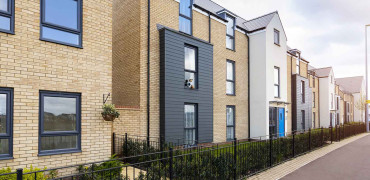At netMAGmedia, we recently held an expert industry round table at RIBA, featuring an in-depth discussion into how we can best serve the nearly 1 million people now living with dementia in the UK with our building designs. Delivering the level of comfort which this major cohort of our ageing society perceives as acceptable is going to be an increasing challenge.
This is an issue that cuts across all sectors, although we focused in particular on the design of healthcare facilities when it comes to supporting the particular set of issues that many people with dementia are confronted with in buildings.
Designing for the particular individual involved in each case was a point of consensus from the event as a crucial element of best practice, but also that designing for all five senses was the ultimate aim.
The event was sponsored by three leading companies, WMS Underfloor Heating, flooring firm Amtico International, and Johnstones Paints. WMS’ representative at the event, MD Ashley Cooper, was very keen to learn how underfloor heating could be used in facilities to help those with dementia feel greater comfort – and therefore less of the distress which can sadly be a common feature of the condition.
The latest heat pumps offer flow temperatures of 75 degrees C, so act pretty much like gas
Setting a new standard
The Future Homes Standard due to emerge in 2025 is likely to require heat pumps to be installed across a wide range of new build and residential accommodation, as well as a range of heat network-based installations over the next few years. However, just because you have a heat pump, it doesn’t mean that you can’t specify underfloor heating, in fact they can work very well together given a thoughtful approach to sizing and specification.
At our meeting however, there was some consternation as to whether people living with dementia would be challenged by the perceived limitations of underfloor heating when it comes to offering a fast response to feeling cold. In fact, underfloor heating, explained WMS, can be precisely controlled using smart technology, including to come on earlier than technically required in order to be up to the required temperature by the time that users may notice it firsthand (or ‘first foot’).
Such smart controls can both achieve the balance between overly cool and excessively warm and wasteful, but can also be set to avoid tampering problems, and can respond to changing weather forecasts. App control enables carers and care staff to take full control of systems using familiar and user-friendly interfaces, and boost systems before people are using spaces.
Temperature and dementia
Cooper of WMS asserted that more and more hospitals were embracing the benefits of underfloor heating, partially driven by its ability to help cut down airborne dust particles that may harbour germs.
However he said that as yet, the benefits for people with dementia “haven’t yet been given a focus,” although there are many existing benefits of systems and controls, such as the latters’ ability to only slightly reduce temperature overnight rather than turning underfloor heating off and on.
Despite the range of benefits, another participant believed there was a concern that for such patients, there is a requirement to quickly increase heating levels in order to address concerns of people with dementia who are feeling cold.
Unlike the ability to open a window and cool a space, there was a perception for some attendees that underfloor heating could not respond quickly, with the “psychological feeling of cold” being as important for some users as the actual temperature. One particular attendee handed Cooper a large dossier of information to help the company become more aware of the many factors around temperature which need to be considered for patients with dementia.
Heat pumps and balance
However, when it comes to heat pumps working with underfloor heating, maybe there is a solution that will go part of the way to achieving a manageable balance. Heat pumps are designed to be virtually never switched off in order to optimise performance efficiency.
Instead they should be controlled to produce a constant temperature, which has typically been around 55 degrees. In terms of care facilities and their estates departments as well as domestic spaces and carers, this does require a major shift from the traditional switch on/switch off approach, but can be made to offer the right balance.
If care staff do need to turn heating off overnight to help people sleep, fan-assisted radiators can be an option to get temperatures up to a level more quickly, but obviously this comes at a cost. However, the latest heat pumps which use propane/R290 refrigerant have the ability to give flow temperatures of 75 degrees C, so act pretty much like gas.
Despite the issues around transitioning to underfloor heating, the potential to lose radiators offers a real boon for dementia care, according to one of our round table delegates, from their personal experience working with users. Although Low Surface Temperature technology is now a given in care units, there is also thought to be a risk associated with falls between furniture and radiators, which can make it extremely difficult for users to feel they are able to escape, leading to potentially life-threatening situations in some cases.
Such learnings are anecdotal by their nature but need to be considered when we are planning for the vast amount of facilities that will be required to be truly supportive for this vulnerable and yet increasingly large part of our society.
James Parker, editor, Architects’ Datafile




